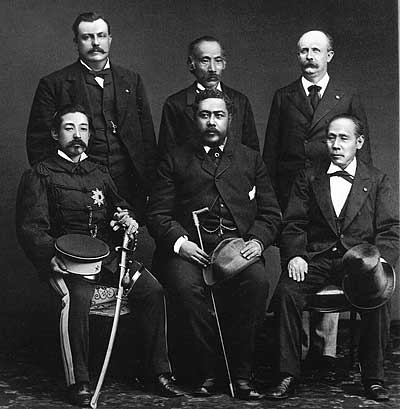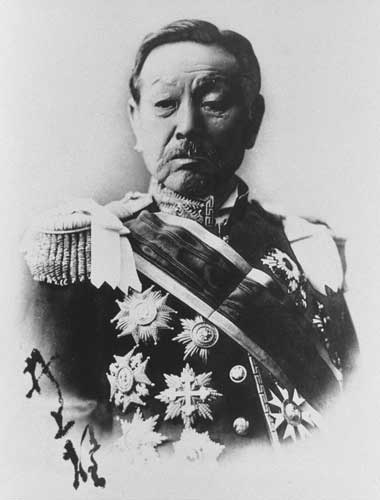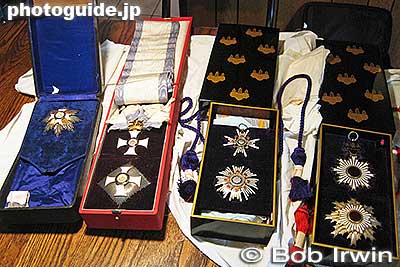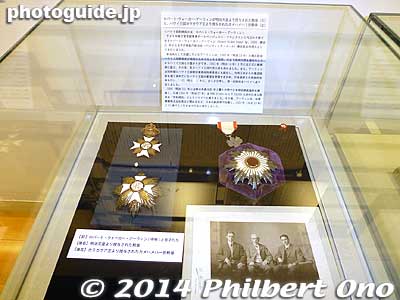Robert Walker Irwin
by Philbert Ono, Updated Sept. 28, 2018
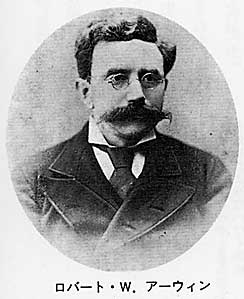 |
| A young Robert Walker Irwin |
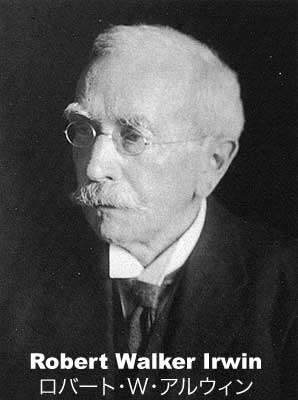 |
| Robert Walker Irwin in later years |
Robert Walker Irwin (ロバート・ウォーカー・アルウィン) (1844-1925) was an American businessman from Philadelphia, Pennsylvania, USA who lived in Tokyo, Japan and was the Hawaiian Minister to Japan and Special Agent and Special Commissioner of Hawaiʻi's Board of Immigration. Representing the Kingdom of Hawaiʻi, he headed the negotiation and management of the government-contracted Japanese immigration to Hawaiʻi during 1885-1894 called Kan'yaku Imin (官約移民).
In Japan, he is called the Father of Japanese Immigration to Hawaiʻi, along with King David Kalakaua who encouraged Japanese immigration to Hawaiʻi. Irwin also had a summer home in Ikaho, a hot spring town in Gunma Prefecture. Part of the house is preserved and open to the public alongside a small museum. This is Ikaho's Hawaiʻi connection and reason for its sister-city ties with the Big Island of Hawaiʻi since 1997.
Irwin hailed from a very distinguished family lineage, on both his mother's and father's sides. Through his mother, Sophia Arabella Bache of Philadelphia, he was a fifth-generation direct descendant of Benjamin Franklin (1706-1790), one of the Founding Fathers of the United States. His mother was a fourth-generation direct descendant, descending from Benjamin Franklin's daughter Sarah (1743-1808) who married a Richard Bache.
Irwin was born on Jan. 4, 1844 in Copenhagen, Denmark as the third son (and one of six children) of Pittsburgh, Pennsylvania native William Wallace Irwin (1803-1856) who was the United States Chargé d’Affaires to Denmark from March 3, 1843, to June 12, 1847. William was also the mayor of Pittsburgh in 1840-41, and elected as a Whig to the Twenty-seventh Congress (March 4, 1841-March 3, 1843) representing Pennsylvania. William was a descendant of a Scottish king (Malcolm II). Sophia Arabella Bache was his second wife. With his first wife Frances Everallyn Rose Irwin, he had a son, John Irwin (1832-1901), who became a United States Navy Rear Admiral and commander of the Pacific Squadron.
The family moved to Philadelphia in 1850 when Robert was 6 years old. His older brother Richard found Robert (while still in high school) a job at the Pacific Mail Steamship Company. Robert headed the company's San Francisco office and was later assigned to head the Yokohama office. At age 22, Robert arrived Japan on Nov. 6, 1866. In 1865, the company had been awarded a contract by the US government for monthly mail service between San Francisco and Hong Kong via Hawaiʻi and Japan. The company started operating trans-Pacific steamship service between San Francisco, Yokohama, and Hong Kong from 1867.
The company later built (in 1874 in Chester, PA) and operated the City of Tokio, the steamship which would bring the first Japanese immigrants to Hawaiʻi in 1885 under the Kanyaku Imin program. (A few months after that historic voyage, the ship in foggy weather ran aground on some rocks near Yokohama in June 1885 and was soon destroyed by a typhoon.)
After his job was done at Pacific Mail Steamship Company, Irwin worked for Walsh Hall & Co., a prominent American trading firm in Yokohama. He successfully headed the Nagasaki office for two years. When he returned to Yokohama around 1871, he met Inouye Kaoru who was then the Vice Minister of Finance in the new Meiji government. Inouye and his Ministry of Finance were burdened with the task of absorbing the debts of the disbanded feudal domains. Irwin gave Inouye some useful advice on financial negotiations that worked. Inouye came to trust Irwin and went to him for advice. Both their families became close friends.
Along with Masuda Takashi (益田 孝), Inouye was also one of the founders of trading company Mitsui Bussan (Mitsui & Co. and its forerunner company) in 1874–1876. It started with a trading company called Senshu Gaisha (先収会社) in 1874 after Inouye left government service and became the company's president. The highly profitable company that exported rice and imported military weapons for the Japanese army was dissolved in 1876 when Inouye returned to government service. However, the company was continued by Mitsui and eventually became Mitsui Bussan, the core company of the Mitsui Zaibatsu conglomerate. Masuda became the company's first president. Irwin handled the foreign import-export business for Senshu Gaisha and later Mitsui Bussan. His ties to Mitsui continued for the rest of his life.
Count Inouye Kaoru was a major figure in the Meiji government and Japan's Foreign Minister during 1879-1887. He once studied in the UK in 1863 as one of the "Choshu Five." In this capacity, Inouye served as the main man in the Japanese government handling the Japanese immigration opposite Irwin. Irwin was thus well-connected in both business and government in Japan.
In 1880, Irwin was appointed as the Kingdom of Hawaiʻi's interim Consul-General in Japan upon the recommendation of the outgoing Consul-General Harlan P. Lillibridge who was also his friend. It was not a busy job for him until he had to start preparing for King David Kalakaua's trip to Japan. In March 1881, during a trip to Japan, Hawaiʻi's King David Kalakaua, duly impressed with Irwin's impeccable preparation for the royal stay in Japan, strong business and government connections, family background, and good nature, promoted 37-year-old Irwin to Hawaiian Minister to Japan. The king announced this promotion in the presence of Imperial family members and high-ranking government officials at the Enryokan State Guesthouse in Hama-rikyu Detached Palace (now a Japanese garden) where he was staying.
Interestingly, Irwin was not from Hawaiʻi and had never lived there even though he was Hawaiʻi's top representative to Japan. Somewhat unthinkable today. Irwin was well-positioned to help negotiate, plan, and manage the government-sponsored Japanese immigration to Hawaiʻi. Irwin eventually successfully negotiated the Kanyaku Imin immigration treaty (see below) for the Kingdom of Hawaiʻi and was with the first shipload of Japanese immigrant laborers who arrived Honolulu in Feb. 1885 under the program.
Irwin and wife Iki also became good friends of Emperor Meiji and the Empress. They were invited to official Imperial functions such as cherry blossom garden parties. The emperor hailed Irwin's lineage to Benjamin Franklin and was impressed that a descendant would marry a Japanese.
First legal marriage between an American and Japanese citizen
Irwin is also noted for being in the first legal marriage between a Japanese citizen and American citizen in 1882. Irwin first met his Japanese wife Takechi Iki (武智イキ Dec. 23, 1851–Aug. 17, 1940) around 1868 when she was still a teenager. During a business trip to Yokohama, Irwin visited a money changer and met Iki for the first time when she brought him some tea. Captivated by her beauty and charm, he fell in love with her and started to persuade her family for her hand in marriage. Iki was the adopted daughter of Takechi Sosuke (武智惣助) who was a successful wholesaler of marine products near Asakusa, Tokyo. The Takechi family were descendants of Minamoto no Yoshinaka (Kiso Yoshinaka), a 12th-century samurai general.
Despite opposition by his family, the Takechi family, and all his American friends in Japan, he finally convinced Iki to marry him about two years after they first met. He was 26 and she was 18 and they moved to Nagasaki where Irwin headed the Walsh Hall & Co. office around 1870. However, it still was not legal for an American to marry a Japanese. Irwin took action and pushed both governments to make the marriage legal. However, it took the Japanese government six years to approve such a marriage, and the U.S. government took 12 years before legalizing it. Irwin (38) and Iki (30) were finally legally married on March 15, 1882. This allowed their future children to be registered as American citizens at the U.S. Consulate in Japan. The marriage was arranged by Foreign Minister Inouye Kaoru.
Iki was 10 years old when she became the adopted daughter of Takechi Sosuke (武智惣助) who was a successful wholesaler of marine products near Asakusa, Tokyo. Iki originally came from the Hayashi family in Iida, Nagano Prefecture. They were a prominent financier family. The well-to-do Takechi family could afford to have Iki be well-trained in reading and writing, calligraphy, tea ceremony, flower arrangement, koto playing, and Japanese dance. The Takechi family were descendants of Minamoto no Yoshinaka (Kiso Yoshinaka), a 12th-century samurai general. Robert never mastered Japanese and could only speak broken Japanese, and Iki could only speak broken English. Yet, they got along very well.
During their first year of their common-law marriage, Irwin and Iki had a baby daughter in Nagasaki who died soon after birth around 1870. It was not until Nov. 1883 when they finally had another child, daughter Sophia Arabella "Bella" Irwin (Nov. 24, 1883–June 12, 1957) born in Tokyo and named after his mother. Bella was followed by five more children: three daughters Mary (Sept. 6, 1885–April 5, 1930), Marian (June 16, 1888–May 10, 1973), and Agnes; and two sons Robert Jr. (June 14, 1887–Oct. 9, 1971), and Richard Akira (May 18, 1890–April 16, 1928). The birth of his children gradually made him stop his excessive drinking and womanizing (mainly geisha) and made him more mellow to the delight of Iki. Eldest daughter Bella became especially close to her parents who absolutely adored her. Irwin spoke in English to his children (who were educated in both Japan and the US). All his children (and grandchildren) grew up to promote friendship and understanding between Japan and America in some way. (More about the children below.)
Kan'yaku Imin 官約移民
By the 1870s, the Kingdom of Hawaiʻi's native population was in serious and tragic decline ever since the white man introduced diseases to which the natives had no immunity. Leprosy was also taking its toll. In 1876, Hawaiʻi's population was only 55,500, one-fifth of the original population. The two top priorities of King David Kalakaua's administration was to increase the native population (with "cognate races") and to advance agriculture and commerce. Besides increasing Hawaiʻi's permanent population, they needed to secure more laborers to work in the sugar cane fields. The Reciprocity Treaty of 1875 between the U.S. and the Hawaiian Kingdom allowed free access to the U.S. market for sugar and other products grown in Hawaii starting in September 1876. This led to major American investments in sugarcane plantations that soon needed more manual laborers. The only answer was immigration to Hawaiʻi from abroad.
Immigration to Hawaiʻi started in earnest from 1876 when immigrants from various countries in Asia (India and China), the South Pacific islands, Portuguese islands (Madeira and Azores), and even Europe (Norway and Germany) were brought to Hawaiʻi. The most numerous were the Chinese. They came to be too numerous with too many men and far too few women. Their large numbers caused various social problems and anti-Chinese sentiments, and restrictions were eventually placed on Chinese immigration. This created a labor shortage again.
Hawaiʻi then looked to Japan. Japanese immigrants had been on Hawaiʻi's mind for years. As early as June 19, 1868, 153 Japanese immigrants, called Gannen-mono (元年者) (First-Year People, since it was the first year of the Meiji Era), came to Hawaiʻi as private (not sanctioned by the government) contract laborers. They were sent by American businessman Eugene Van Reed. They were hardworking and well-behaved, giving the Japanese a good reputation as a source of immigrants to serve as laborers and help repopulate the kingdom. But they were treated poorly by the sugar planters, and the Japanese government became concerned.
The Japanese government was slow in responding to Hawaiʻi's immigration proposals due to its own domestic problems and concerns over their citizens being mistreated. The immigration issue later hinged on Japan's success in first revising unfair treaties with other Western powers. The Hawaiian government could not wait that long and kept negotiating and sending envoys to Japan.
In March 1881 when King Kalakaua visited Japan during his world tour, he struck up a personal friendship with Emperor Meiji. He even proposed that his beloved six-year-old niece Princess Kaiulani be betrothed to a Japanese prince (Prince Higashifushimi Yorihito) who had impressed the king. (The proposal was later politely declined.) The subject of immigration was also brought up. The king expressed that the Hawaiian government wanted to increase its population by inviting immigrants from other countries. And that any Japanese who desired to settle in Hawaiʻi would be permitted to do so.
In Nov. 1882, the highly-regarded former Maui governor John M. Kapena, a native Hawaiian, was sent to Tokyo instructed to emphasize racial affinity between Hawaii and Japan and to encourage Japanese immigration. At a dinner in Tokyo, he gave an amazing speech:
His Majesty (Kalakaua) believes that the Japanese and Hawaiians spring from one cognate race and this enchances his love for you. He hopes that our people will more and more be brought closer together in a common brotherhood. Hawaii holds out her loving hand and heart to Japan and desires that Your People may come and cast in their lots with ours and repeople our Island Home — with a race which is sent to us by His Imperial Majesty, Your government and people may blend with ours and produce a new and vigorous nation making our land the garden spot of the Eastern Pacific, as your beautiful and glorious county is of the Western. (From The Hawaiian Kingdom 1874-1893, by Ralph Kuykendall)
Kapena also met with Foreign Affairs Minister Inouye Kaoru and stated terms and conditions (including wages) proposed by the Hawaiian government for Japanese immigrants. Kapena duly impressed the Japanese, but Japan still was not ready to allow immigration to Hawaii.
In March 1883, Irwin was appointed Special Commissioner for Japanese immigration and was entrusted to continue immigration negotiations with Japan. To help Irwin, another native Hawaiian, Colonel Curtis Piehi Iaukea, was sent to Japan in April 1884 as envoy extraordinary and minister plenipotentiary. Iaukea met with Irwin, Foreign Minister Inouye, and even the emperor. He stated Hawaiʻi's proposed terms and conditions for immigration. Although Inouye declined to conclude an immigration treaty at this time, he told Iaukea that Japan would not block any immigration to Hawaiʻi. This tacit approval finally put Hawaiʻi's Japanese immigration plans in motion.
It so happened that Japan was facing a major economic recession due to the Satsuma Rebellion in 1877 and crop failures and discontent among farmers in Japan. Giving them the option of going to Hawaii might relieve some of the domestic stress.
On Jan. 27, 1885, the first group of 943 Japanese immigrants under the Kanyaku Imin program ("Kan" means government [官], "yaku" means contract [約], and "Imin" is immigration [移民]) departed Yokohama and arrived Honolulu on Feb. 8, 1885 aboard the Pacific Mail Steamship City of Tokio. They were 676 men, 159 women, and 108 children who had free passage, expenses paid by the Hawaiian government. Their monthly wage was $9 for the men, and $6 for the women. They would also receive a food allowance, free housing, and free medical care. They were to work 10 hours a day and 26 days per month. It was a three-year contract with the Hawaiian government.
Along with wife Iki and 14-month-old daughter Bella, Irwin accompanied this first group of Japanese. (Iki got really seasick and declined to travel anymore to Hawaiʻi or the States. Her first and last overseas trip.) The immigrants received a grand welcome in Honolulu under the direction of King Kalakaua. The Royal Hawaiian Band played, and policemen served as tour guides. A few days later on Feb. 11, 1885, the Japanese immigrants returned the gracious welcome by demonstrating kendo fencing, fireman's acrobatics on an upright ladder, and the intriguing sport of sumo which Irwin explained to the King and the rest of the audience. They even wore makeshift kesho mawashi ceremonial aprons (made of blankets) and performed the ring-entering ceremony. The event was capped by drinking and offering barrels of sahke to the audience. The sake was apparently brought aboard together with the immigrants, arranged by Irwin or the King.
Irwin did all he could to make the Japanese immigration a success. He sought to educate Hawaiian officials and sugar plantation agents and owners about the Japanese immigrants. He made a list of excellent suggestions for managing the Japanese laborers. This memo was circulated among the Board of Immigration and the plantation employers. And in Japan, he kept the Japanese government and people informed about the situation in Hawaiʻi. (Unfortunately, some plantations were still excessively harsh on the immigrants, prompting some of the laborers to stop working within a month.)
 |
| Bilingual (English on left, Japanese on right) Kanyaku Imin labor contract signed by R.W. Irwin as Hawaii's Special Agent and Special Commissioner of the Board of Immigration and an immigrant named Saka Shoshichi in Jan. 1885 (facsimile exhibited at the Japanese Overseas Migration Museum in Yokohama). |
 |
| ''City of Tokio'' steamship (picture exhibited at the Japanese Overseas Migration Museum in Yokohama) |
Irwin went back to Japan and returned to Hawaiʻi a few months later with the second shipload of Japanese immigrants arriving Honolulu on June 17, 1885 on the Yamashiro Maru (山城丸). They were 930 men, 34 women, and 14 children.
On Jan. 28, 1886, after Japan was rest assured that its citizens in Hawaii would be treated fairly, a formal immigration treaty between Japan and Hawaii was finally signed by Japan in Tokyo. The actual signatures came from three close friends: Japanese Prime Minister Ito Hirobumi, Japanese Foreign Minister Inouye Kaoru, and Special Agent and Special Commissioner of Hawaiʻi's Board of Immigration Robert Walker Irwin. The official seal of Emperor Meiji was also imprinted. The treaty stipulated that all Japanese immigrants would go to Hawaiʻi under a contract not exceeding three years, signed at Yokohama by the Special Agent (Irwin) of Hawaiʻi's Board of Immigration, the immigrant concerned, and subject to approval by the Governor of Kanagawa.
The Hawaiian government would be held responsible for the employer's treatment of the immigrants and the faithful execution of the contract. The Hawaiian government would also provide free transportation* from Yokohama to Honolulu on first-class passenger steamships and provide an adequate number of interpreters, inspectors, and Japanese physicians. The treaty would be valid for five years. (*This proved to be too expensive, so from the fourth shipload, the immigrants were made to bear part of the transportation cost, usually paid in monthly installments after they started working.)
On the Japanese side, the treaty conditions and negotiations were handled by Foreign Affairs Minister Inouye Kaoru who was already a personal friend of Irwin. He allowed Irwin to send a third shipload of Japanese immigrants who arrived Honolulu on Feb. 14, 1886 on the City of Peking (sister ship of the City of Tokio) operated by the Pacific Mail Steamship Co. Irwin was also on board with the immigration treaty for ratification by the Hawaiian government.
The door was thus opened wide for large-scale Japanese immigration to Hawaii sponsored by the governments of Japan and Hawaii. Immigrants from Yamaguchi and Hiroshima Prefectures developed an excellent reputation as laborers and more of them were recruited than anywhere else in Japan. The Kanyaku Imin immigration lasted from Feb. 8, 1885 to June 27, 1894. Although there were several interruptions due to arguments by the two governments over the terms and conditions, a total of twenty-six shiploads of immigrants brought around 29,000 Japanese men, women, and children during this period. For Irwin, it was a lucrative venture as he reportedly received a $5 commission for each adult male immigrant he recruited.
Over 7,000 Kanyaku Imin immigrants eventually returned to Japan by the end of 1894, still leaving over 20,000 Japanese in Hawaiʻi. This was 20 percent of Hawaiʻi's population. However, this was only the beginning. The bulk of Japanese immigration (including Okinawan immigration starting in 1900) occurred after this period through private channels up until 1924 when the U.S. Congress prohibited further immigration from Japan. By 1910, 40% of Hawaiʻi's population was Japanese, numbering almost 80,000. By 1924, over 200,000 Japanese immigrants had arrived in Hawaiʻi. It was a spectacularly successful effort to repopulate Hawaiʻi. If you have ancestors who were Japanese immigrants to Hawaiʻi, find out what year they arrived in Hawaiʻi. Then you will know if they were part of the Gannen-mono (1868), Kanyaku Imin (1885-June 1894), or a private immigration scheme (July 1894-1924).
In 1952, the McCarran-Walter Act allowed immigration from Japan again. It also made the Issei eligible for naturalization.
Ikaho 伊香保
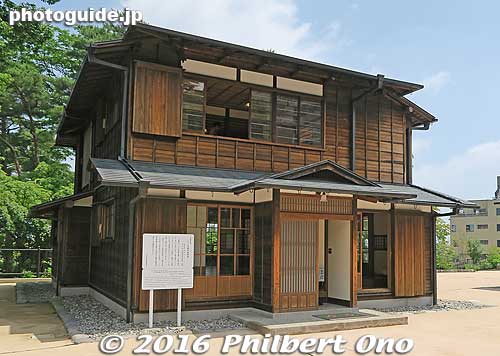 |
| Preserved summer residence of Robert W. Irwin in Ikaho, Gunma |
 |
| Inside the summer residence of Robert W. Irwin in Ikaho. More photos of the museum here. |
In 1891, upon the auspices of Count Inouye Kaoru, Irwin purchased a summer villa in Ikaho, Gunma Prefecture to escape Japan's hot summers (Ikaho is now a part of the city of Shibukawa). Irwin purchased the villa under his wife's niece Kiku Takechi's name since foreigners were not allowed to buy real estate in Japan. He enjoyed the hot spring town's coolness and quiet. Conveniently located slightly above the foot of the Stone Steps, the spacious villa on about 300 sq. meters of land also served as the Kingdom of Hawaiʻi's secondary legation and used by Irwin's Tokyo staff and guests from Hawaiʻi. Irwin and his family spent every summer in Ikaho until his death in 1925. Ikaho is a centuries-old hot spring town first established in the 16th century. During the Meiji Period in the late 19th century, it was an upscale hot spring resort and summer retreat frequented by famous novelists and artists like Natsume Soseki and Takehisa Yumeji as well as prominent foreigners who were allowed to travel to Ikaho (along with Nikko and Hakone). The Imperial family even had a summer villa in Ikaho until 1945 (now occupied by Gunma University).
Eldest daughter Bella Irwin (1883-1957) loved Ikaho and was popular there. Whenever she went for a walk, the neighborhood kids would follow her around. Eventually she invited them to the summer residence where she showed them picture books from abroad and offered sweets. It later became a teacher-student relationship as she started teaching the kids (and later adults) at the Ikaho residence. Upon the approval of her parents, she started a Christian Sunday School in Ikaho in 1904. To enhance her qualifications as a teacher, she later went to study preschool education in the US. However, Christian Sunday Schools were being persecuted in Japan, forcing Bella to close her Sunday School in Ikaho. She went to Tokyo where she established the forerunner of the Irwin Gakuen nursery teacher training school and kindergarten in 1916 in Kojimachi.
In 1927, the Irwin summer home was sold to Noma Seiji (野間清治), the president of Kodansha, a major publishing house. It was used for training the company's young employees. The facility was later purchased by Gunma Prefecture in 1944, and operated as the Kanzanso inn by Gunma's social welfare association (群馬県社会福祉協議会). It was finally owned by Ikaho town (now part of Shibukawa city) in 1985.
On Oct. 1, 1985, to mark the 100th anniversary of the Kanyaku Imin, the town of Ikaho in Gunma Prefecture designated Irwin's former summer residence as a Historic Site of Ikaho (伊香保町指定史跡) and proceeded to preserve the remaining part of the residence which was moved near the bottom of the Stone Steps. In return, Hawaii's Governor George Ariyoshi, a descendant of Japanese immigrants and America's first Japanese-American governor, sent a letter of appreciation to the town and people of Ikaho.
The summer residence or villa (called Hawaiʻi Koshi Bettei ハワイ公使別邸 or Robert W. Irwin Bettei ロバート・W・アルウィン別邸) opened to the public as a history museum of the Irwin family and Japanese immigration to Hawaiʻi (free admission). It was only a small section of the original summer home. In autumn 2013, the home was moved to its current (and original) location slightly up the Stone Steps in place of the Kanzanso inn that was torn down. For the move, the building was disassembled and repairs were made where necessary. The home was then reassembled with new exterior walls, floors, roof, etc. English pamphlet here (written by Philbert Ono, uncredited).
In April 2014, a small, new museum called the "Guidance Facility" (ガイダンス施設) opened next to the Irwin summer home. Artifacts previously exhibited in the Irwin summer home were moved to the new museum. The new museum displays artifacts and exhibits related to the Irwin family and Robert Walker Irwin's role in the Japanese emigration to Hawaiʻi. Map here | Photos here. Address: Ikaho 32, Ikaho-machi, Shibukawa, Gunma Pref.
On Jan 22, 1997, citing its Hawaiʻi connection through the Irwin summer house, Ikaho established sister-city relations with the County of Hawaiʻi (island of Hawaiʻi). In the summer of that year, Ikaho started to hold the annual King Kalakaua "The Merrie Monarch" Hawaiian Festival featuring hula performances by numerous hula groups from various parts of Japan and Hawaiian workshops taught by a well-known kumu hula (recognized hula teacher) from Hawaiʻi.
The Ikaho hula festival is held for a few days in late July or early August before Japan's Obon summer break. All day long, Japanese hula dancers perform one after another on the outdoor main stage and on the Stone Steps. The main highlight is a nightly hula performance by the overall winner or one of the top winners of the Merrie Monarch Festival, the world's most prestigious and famous hula competition held in April in Hilo, Hawaiʻi. One of Hawaiʻi's top hula halaus (hula school or troupe) is thus invited to Ikaho every summer. Ikaho's hula festival is officially sanctioned by the Merrie Monarch Festival.
Among the many hula festivals in Japan, Ikaho's Hawaiian Festival is unique because it is organized by a municipal government (based on sister-city relations) instead of a private company. The Merrie Monarch refers to King David Kalakaua who revived hula dancing (suppressed by the missionaries) during his reign and liked to have fun.
- Directions: Map here. From the Buster Shinjuku bus terminal at JR Shinjuku Station (near South Exit) in Tokyo, there are JR buses to Ikaho, taking 2.5 hours. Get off at the Ikaho Ishidangai stop (伊香保石段街) at the bottom of the Stone Steps. Day trippers can store luggage in the nearby lockers. Irwin's villa is a short distance up the Stone Steps on the right side. Also see: https://www.ikaho-kankou.com/en/access/
- For other Japanese-American museums in Japan, see Japanese-American and Nikkei Museums in Japan.
Robert Walker Irwin Chronology
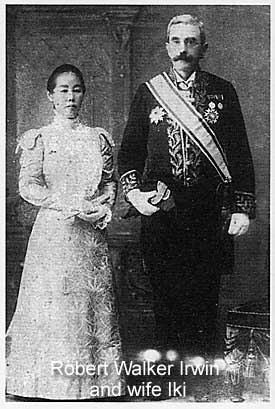 |
| Robert Walker Irwin and wife Iki |
- 1844 Jan. 7: Born in Copenhagen, Denmark.
- 1850: Moved to Philadelphia, Pennsylvania, USA.
- 1856: Irwin's father William Wallace Irwin dies of heart failure at age 53, leaving behind Robert (age 12), eldest son Richard, and daughters Agnes, Sophia and Mary.
- 1860: The Treaty of Amity and Commerce between the United States and Japan signed in 1858 was ratified with the visit of the first Japanese Embassy to the United States. The Japanese Embassy also visited Philadelphia and their exotic appearance made an unforgettable impression on 16-year-old Robert. It made him want to visit Japan someday.
- 1866 Nov. 6: Arrives in Japan to staff the Japan branch of the Pacific Mail Steamship Company in Yokohama. Helped to establish the company's trans-Pacific steamship service between San Francisco, Yokohama, and Hong Kong that started in 1867.
- 1867 Jan. 30: Emperor Komei, who was against foreigners in Japan, dies. Succeeded in the following month by his 14-year-old son Emperor Meiji (Mutsuhito).
- 1867 Nov.: Tokugawa Yoshinobu, the last Tokugawa shogun, abdicates as shogun, returning governing power to the emperor.
- 1868 January 27–1869 June 27: Boshin War breaks out between pro-emperor Imperial forces led by the Choshu, Satsuma and Tosa Clans and Tokugawa shogunate forces who are defeated to restore Imperial rule by the emperor.
- 1868 June 19: The first Japanese contract laborers (153) called "Gannenmono" are sent to Hawaii by businessman Eugene Van Reed.
- 1868 Oct.: The Meiji Period begins with Emperor Meiji moving from Kyoto to Edo, renamed "Tokyo." Japan start to modernize and adopt all things Western. The movers and shakers of the Meiji Period were young men like Shibusawa Eiichi, Inouye Kaoru, Ito Hirobumi, and Masuda Takashi who were all internationally-oriented and would become friends of Robert.
- 1869: Works for Walsh Hall & Co. (ウォルシュ・ホール商会), an American trading firm in Yokohama run by the Walsh brothers. The company sold warships, weapons, and gunpowder to the shogunate and daimyo, and procured rice, tea, and silk from Japan. In 1877, the company started one of Japan's earliest paper mills, the Kobe Paper Mill in Kobe (morphing into Mitsubishi Paper Mills). After a year, Irwin leaves Yokohama to head the Nagasaki office. Around this time during a business trip to Yokohama, he meets teenager and future wife Takechi Iki for the first time.
- 1870: Around this time, after two years of courtship, Robert convinces Iki to be his wife and they go back to Nagasaki together. They later return to Yokohama from Nagasaki, while he is still at Walsh Hall & Co.
- 1871 Sept. 14: Meets Inouye Kaoru and gives sound advice for financial negotiations concerning the liabilities of the disbanded feudal domains. A close friendship with Inouye and his family ensues.
- 1872 April: Visits Kyoto.
- 1874: Helps Count Inouye Kaoru establish the forerunner company (先収会社) of trading company Mitsui Bussan (Mitsui & Co.).
- 1874: David Kalakaua (1836-1891) is elected King of the Hawaiian Kingdom. He reigns until his death in 1891.
- 1875: Reciprocity Treaty between the U.S. and the Hawaiian Kingdom is signed and ratified to allow free access to the U.S. market for sugar and other products grown in Hawaii starting in September 1876. This led to major American investments in sugarcane plantations that soon needed more manual laborers.
- 1876 July: Arranged a trip to the U.S. for Count Inouye Kaoru, his wife and daughter, and about twenty assistants and students to tour San Francisco, Nevada, Chicago, Niagara Falls, and Philadelphia, Pennsylvania in August to see the Philadelphia Centennial Exposition. Irwin served as their guide in the U.S. Also starts working as an advisor for Mitsui Bussan, a trading company established this year.
- 1877 April 22: Left for the UK to start up a company in June named "Irwin and Company" which eventually became the London office of Mitsui Bussan to market Japanese products to Europe.
- 1878 Oct.: Leaves London and returns to Yokohama. Irwin and Company in London is then headed by Irwin's older brother Richard. About two years later, the company becomes Mitsui Bussan's first overseas office headed by a Japanese manager trained by the Irwin brothers. Richard remains in the UK for several years to assist.
- 1879 Nov. 14: Becomes an advisor to Mitsui Bussan, being paid the same amount as his friend and company president Masuda Takashi.
- 1880: Appointed as the Kingdom of Hawaii's Consul-General in Japan to succeed Harlan P. Lillibridge who resigned.
- 1881 March 4–16: Hawaii's King David Kalakaua visits Japan and meets Irwin.
- 1881 May 7: Irwin is appointed (promoted) Hawaiian Minister to Japan.
- 1881 May 7: Awarded the Knight Companion of the Royal Order of Kalakaua by King Kalakaua.
- 1882 July: The Kyodo Unyu Gaisha shipping company (共同運輸会社) is established by the Mitsui group with Irwin as an advisor. In 1885, this company merges with rival Mitsubishi's shipping company to form a shipping company known today as NYK Line (Nippon Yusen Kabushiki Kaisha)
- 1882: Awarded the 4th Class, Order of the Rising Sun, Gold Rays with Rosette (勲四等旭日小綬章) by the Japanese government.
- 1882 Sept. 18: Legally marries Takechi Iki (武智イキ 1851–1940) as arranged by Foreign Minister Inouye Kaoru as the first marriage between an American and Japanese citizen approved by both governments.
- 1883 Mar. 10: Appointed by Hawaii as Special Commissioner for Japanese immigration.
- 1883: Becomes the Foreign General Manager of Kyodo Unyu Kaisha (共同運輸会社), Mitsui's shipping company.
- 1883 Nov.: First child and eldest daughter, Sophia Arabella "Bella" Irwin (1883-1957), born in Tokyo.
- 1884: Travels to Honolulu, Hawaii (with Colonel Curtis Piehi Iaukea) in May to discuss plans with the Hawaiian government to start the Japanese immigration. While in Hawaii, he is appointed as as Special Agent of the Hawaiian Board of Immigration and Commissioner for Japanese immigration. He returns to Japan by the end of Aug.
- 1885 Feb 8: The first group of Japanese immigrants under the Kanyaku Imin program arrives Honolulu aboard the Pacific Mail Steamship City of Tokio. Irwin accompanies this first group.
- 1885 Feb. 26: Appointed as the Kingdom of Hawaii's Chargé d'affaires and Consul-General to Japan. Also, awarded the Knight Commander of the Royal Order of Kalakaua by King Kalakaua.
- 1885 April 13: Awarded the 3rd Class, Order of the Rising Sun, Gold Rays with Neck Ribbon (勲三等旭日中綬章) by the Japanese government.
- 1885 June 17: Irwin arrives Honolulu with the second group of 978 Japanese immigrants aboard the Yamashiro Maru.
- 1885 Sept. 6: Daughter Mary is born.
- 1886 Feb. 14: The third group of Japanese immigrants arrive Honolulu on the City of Peking operated by the Pacific Mail Steamship Co. Irwin was also on board bringing the immigration treaty (signed by Japan on Jan. 28, 1886) for signing by the Hawaiian government.
- 1886 March 30: Awarded the Knights Commander of the Royal Order of Kamehameha I by King Kalakaua.
- 1886 Oct. 4: Awarded the 2nd Class, Order of the Rising Sun, Gold and Silver Star (勲二等旭日重光章) by the Japanese government.
- 1887–1894: Kan'yaku Imin immigration continues with a few shiploads every year.
- 1887 June 14: First son Robert Walker Jr. is born.
- 1888 June 16: Third daughter Marian is born.
- 1890 May 18: Second son Richard Akira is born.
- 1891 Jan. 20: King Kalakaua dies of an illness in San Francisco, CA. Succeeded by Liliʻuokalani.
- 1891: Under the name of Iki's niece Takechi Kiku, he purchases a summer home in Ikaho, Gunma Prefecture where he then spends every summer for the rest of his life. The summer home was previously a Japanese-style inn with a Japanese garden.
- 1892 Mar. 15: Awarded the 1st Class, Grand Cordon of the Order of the Sacred Treasure (勲一等瑞宝大綬章) by the Japanese government.
- 1893 Jan.: The Hawaiian Kingdom is overthrown by Americans and Queen Liliʻuokalani is deposed. A Provisional Government is established.
- 1893 Dec. 4: Irwin visits Honolulu. By coincidence, he meets his half brother John Irwin, Rear Admiral in the US Navy, who was in Honolulu from Dec. 1893 to early Jan. 1894 in command of US Navy ships when the US tried to force Hawaii's Provisional Government to restore the overthrown Hawaiian Kingdom. Irwin stayed aboard his brother's flagship USS Philadelphia. The Japanese cruiser Naniwa commanded by Togo Heihachiro was also on hand to protect its nationals in Hawaii.
- 1894 April 11: Irwin returns to Japan.
- 1894 July 4: The Republic of Hawaiʻi is proclaimed and Sanford B. Dole becomes President.
- 1894 July 7: Irwin accepts an appointment as the Republic of Hawaiʻi's Minister Resident (在日弁理公使) in Japan.
- 1894 June 28: Japanese immigration to Hawaii under the Kanyaku Imin government contract ends with the arrival of the 26th shipload of immigrants. The program brought a total of 29,339 Japanese immigrants to Hawaii. Japanese immigration continues in the private sector until 1924.
- 1895 April: After Japan defeats China in the First Sino-Japanese War, the resulting Treaty of Shimonoseki cedes Taiwan to the Empire of Japan which would rule it until 1945.
- 1896 Feb. 16: Meets with Ernest Satow to discuss Korea.
- 1898 Aug. 12: Hawaii is annexed to the U.S.
- 1898 Oct. 4: Irwin and wife Iki have an audience with Emperor Meiji.
- 1900: Together with Masuda Takashi, Inouye Kaoru, and Shibusawa Eiichi, establishes the Taiwan Sugar Company (台湾製糖株式会社) (later merges with Mitsui Sugar Co.) in Taiwan (part of the Japanese Empire) and becomes an advisor. Irwin had thought of Taiwan as having a similar climate as Hawaii suitable for growing sugar cane.
- 1904: Eldest daughter Bella starts a Christian Sunday School at the Ikaho summer home.
- 1905 June: Travels to New York and meets with Viscount Takahashi Korekiyo.
- 1904 February 8–1905 September 5: Japan shockingly defeats Russia in the Russo-Japanese War.
- 1910: Korea is officially annexed to the Empire of Japan (to end in 1945).
- 1914 Nov. 4: Resigns as advisor to the Taiwan Sugar Company and retires from the business world at age 70 to focus on his family.
- 1916: Eldest daughter Bella founds the Irwin Gakuen school and kindergarten (アルウィン学園) in Kojimachi, Tokyo.
- 1923 September 1: Great Kanto Earthquake strikes the Kanto Region causing major damage and over 100,000 deaths. The Irwin home in Kojimachi, Tokyo remains safe. Richard was initially trapped in his collapsed Standard Oil office building in Yokohama, but managed to get out and get to the ocean where he swam to a boat offshore.
- 1925 Jan. 5: Dies of an illness at age 81. Buried at Aoyama Cemetery in Tokyo. Awarded the 1st Class, Order of the Rising Sun with Paulownia Blossoms, Grand Cordon (勲一等旭日大綬章) by the Japanese government.
- 1927: The Irwin summer home is sold to Noma Seiji (野間清治), the president of Kodansha, a major publishing house. It is used for training young employees. The facility is later purchased by Gunma Prefecture in 1944, and finally owned by Ikaho town (now part of Shibukawa city) in 1985.
- 1928 April 16: Second son Richard Akira (b. May 18, 1890) commits suicide at age 38, leaving behind 28-year-old wife Ichiko, six-year-old son Takeo, and three-year-old daughter Yukiko. From the following year, Takeo and Yukiko are raised by their Grandmother Iki and Aunt Bella.
- 1930 April 5: Second daughter Mary (b. Sept. 6, 1885) dies at age 45.
- 1931 Sept.: Japan invades Manchuria and creates a puppet state named Manchukuo lasting until 1945.
- 1940 Aug. 17: Wife Takechi Iki (b. Dec. 23, 1852) dies at age 87.
- 1941 Dec. 7: Japan attacks Pearl Harbor in Hawaii.
- 1945 March: Tokyo suffers massive firebombing by US bombers.
- 1945 Aug.-Sept.: World War II ends with the nuclear bombings of Hiroshima and Nagasaki by the U.S.
- 1957 June 12: Eldest child and daughter Sophia Arabella (b. Nov. 24, 1883) dies at age 73.
- 1971 Oct. 9: Eldest son Robert Walker Jr. (Ichiro) (b. June 14, 1887) dies at age 84.
- 1973 May 10: Daughter Dr. Marian Irwin Osterhout dies.
- 1985 Oct. 1: For the 100th anniversary of the Kanyaku Imin, the town of Ikaho in Gunma Prefecture designates Irwin's former summer residence as one of the town's Historical Places 伊香保町指定史跡 and proceeds to preserve the remaining part of the residence which is moved toward the bottom of the Stone Steps. Hawaii also celebrates the 100th anniversary with exhibitions and events.
- 1985: Grandson John Tsuneaki Irwin (1926–2016, son of Robert Walker Irwin Jr.) donates to the Diplomatic Archives of the Ministry of Foreign Affairs of Japan (外交史料館) 237 English documents, 122 Japanese documents, and 10 French documents from Robert Walker Irwin's collection.
- 1997: Citing its Hawaii connection through the Irwin summer residence, Ikaho establishes sister-city relations with the County of Hawaii (island of Hawaii) on Jan. 22. Ikaho starts to hold the annual King Kalakaua "The Merrie Monarch" Hawaiian Festival from that summer. (Ikaho town later merged with the neighboring city of Shibukawa on Feb. 20, 2006, making Shibukawa the sister city to the County of Hawaii.)
- 2006 Feb 20: Ikaho town merges with the city of Shibukawa in Gunma Prefecture.
- 2012 July 26: Granddaughter Yukiko Irwin (1925–2014, daughter of Richard) donates two medals to the Japanese Overseas Migration Museum in Yokohama where they are on public display. One medal was awarded by King Kalakaua of Hawaii and the other was awarded by Emperor Meiji. (See photo.)
- 2013 autumn: After two years of disassembly and major renovations, the former Irwin summer residence is reassembled and relocated to its original location slightly up the Stone Steps. The roof, exterior walls, floor, etc., were restored with new materials. The building is Map here
- 2014 April: A "Guidance Facility" museum (ガイダンス施設) opens next to the relocated Irwin summer residence. The new museum displays artifacts and exhibits related to the Irwin family and Robert Walker Irwin's role in the Japanese emigration to Hawaiʻi. Artifacts previously exhibited in the Irwin summer residence are moved to the new museum. The second floor of the home is also opened to the public on weekends and national holidays.
- 2014 Dec. 6: Granddaughter Yukiko Irwin (daughter of Richard Irwin) dies in New York at age 89.
- 2016 Dec. 11: Grandson John Tsuneaki Irwin (first son of Robert Walker Irwin Jr.) dies in California at age 90.
- 2018 Feb.: Grandson Charles Irwin (second son of Robert Walker Irwin Jr.) dies in California.
- 2018 Aug. 11: The partial ashes of grandchildren Yukiko Irwin and John Tsuneaki Irwin are buried with their parents and grandparents at the Irwin family gravesite at Aoyama Cemetery.
Note: In Japanese, Robert Walker Irwin's name is written as ロバート・ウォーカー・アルウィン. However, you might see "Irwin" commonly written as アーウィン instead, which is more accurate pronunciation-wise, but apparently not the official spelling. "Robert" might also be rendered as ロベルト instead of ロバート. "Irwin" is archaically rendered as アルウィン on the Kanyaku Imin labor contracts and Bella's school is アルウィン学園. Old official Japanese documents also render his name as ロベルト ウオルカー アルウヰン.
About Irwin's siblings: Robert Walker Irwin was one of six children of William Wallace Irwin. His older brother John Irwin (1832-1901) was a half brother born to William's previous wife. He became a Rear Admiral in the US Navy in 1891 and retired in 1894. In Dec. 1893 to early Jan. 1894, John Irwin was in Hawaii in command of US Navy ships when the US tried to force Hawaii's Provisional Government to restore the overthrown Kingdom. Another elder brother, Richard Biddle, headed the London, UK office of Mitsui. His older sister Agnes Irwin (1841-1914) founded the Agnes Irwin School in 1869 in Philadelphia and was the first dean of Radcliffe College in 1894. The Agnes Irwin School still exists today as an all-girl, non-sectarian, day school for PreK-Grade 12. Perhaps Aunt Agnes was an influence on niece Bella who started a school of her own in Japan. Younger sister Sophia became the principal of the Agnes Irwin School, and youngest sister Mary was married to a prominent political figure in New York.
About Robert Walker Irwin's Children
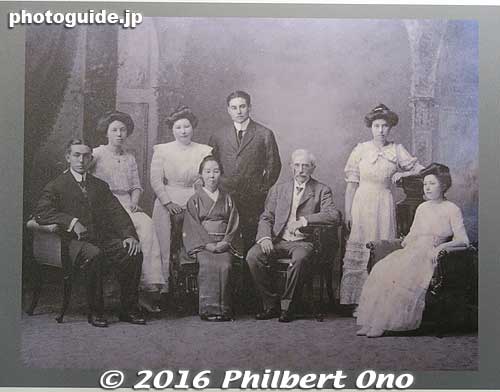 |
| Left to right: Robert Jr., Bella, fourth daughter Agnes, Iki, second son Richard, Robert, third daughter Marian, and second daughter Mary. |
As mentioned above, Robert W. Irwin and wife Iki had six children. They were all very well educated in both Japan and the US at private schools, even the girls. They had a governess from the UK and all first graduated from primary school in Japan, then went to the US for further schooling. It was tough at first to adjust to life and school in the US. The child was accustomed to doting parents and Japanese servants in Japan, but it was different in the US where independence and individuality were important. But each child had the security of having a grandmother (Robert's mother), aunts, and other relatives nearby. Robert would also visit his child studying in the US at least once or twice a year. Up to high school graduation, the child usually would not be able to visit Japan for 5 or 6 years since summer vacations were filled with summer camp or stays at a relative's lakeside villa. This must have been tough on mother Iki who declined to travel overseas. They could visit Japan during summer vacation only while in college. Most of the children did well in school. Robert wanted them to eventually attend Harvard, Yale, or Princeton University. Only one of the six children eventually settled in the US permanently. The rest settled down in Japan.
Being biracial children in their time in Japan must have presented a unique set of challenges for them and their children especially during the war years. The Irwin children did contend with identity issues. In Japan, they did not feel completely Japanese, and in America, they did not feel completely American either. Many Japanese in those regarded half-Japanese people to be "impure." However, being well-connected members of high society, the Irwins were largely insulated from petty prejudices.
It's hard to imagine to have a father or grandfather who had worked to establish good relations between Japan and Hawaiʻi only to eventually see Japan attack Hawaiʻi to start a horrific war. There are significant written records of most of the children, but Sophia Arabella was the one who left a lasting legacy in Tokyo.
Oldest child and daughter Sophia Arabella "Bella" Irwin (Nov. 24, 1883–June 12, 1957) was born in Tokyo. In 1887, she was baptized in a Japanese Christian church. She graduated from Futaba Primary School (雙葉小学校), a private Christian school for girls, in Tokyo at age 12, then went to school in Philadelphia, Pennsylvania. Mother Iki wrote over 100 letters to Bella during this time. Upon graduation, she studied at Columbia University for one summer. She returned to Japan in 1901. In 1904, Bella started a Christian Sunday School in Ikaho using part of the Irwins' summer villa. Bella also studied tea ceremony, flower arrangement, and koto playing.
In 1906, she went back to Philadelphia to study preschool education under the supervision of her Aunt Agnes (founder the Agnes Irwin School in 1869 in Philadelphia) and Aunt Sophia who were both educators. They decided that instead of going to a four-year university, Bella got a general university education from a specialist and got private tutoring in musical rhythm and physical education. She also went to nutrition school for one year and became a qualified nutritionist. She also attended a school in Philadelphia to learn preschool education and graduated s year later with honors. She got interested in Froebel gifts and wanted to study it further.
In 1914, she studied under Maria Montessori in Rome, Italy and did research on Froebel gifts at the Pestalozzi-Fröbel-Haus in Germany. She returned to Japan and prepared to open her new school. In 1916, she used her own assets to found the Gyokusei Nursery Teacher Training School (玉成保姆養成所, renamed as Gyokusei Hoiku Senmon Gakko 玉成保育専門学校 vocational school in 1977) and Gyokusei Kindergarten (玉成幼稚園) in Kojimachi, Tokyo. Bella was the school’s first principal for the first class of 11 nursery teacher trainees and 10 kindergarteners. In 1942, Bella became a Japanese citizen and adopted kanji characters for her name (有院 遍良).
In 1947, they reorganized as the Irwin Gakuen (アルウィン学園) in accordance with Japan’s education reforms with Bella serving as its first director and principal. In 1952, the school moved to its present location in Suginami Ward, Tokyo. In 2016, the Irwin Gakuen school celebrated its 100th anniversary. Bella never married and never had children of her own, but her legacy lives on in Japan.
Robert Walker Irwin's second daughter Mary Irwin (Sept. 6, 1885–April 5, 1930) suffered from nervousness from an early age and was physically weak. After graduating from high school in the U.S., she declined to go to college and returned to Japan and lived with her parents. As she got older, her "neurasthenia" condition worsened. Robert once took her to Paris to study the piano and she even gave two recitals in the U.S. But she returned to Japan when her condition worsened. She suffered nervous attacks much to the concern of her parents who kept her as a family secret. She died at age 45, after her father but before her mother.
Eldest son Robert Walker Irwin Jr. (June 14, 1887–Oct. 9, 1971) was born in Shiba, Tokyo. He graduated from Gyosei Primary School (暁星小学校) in Tokyo. Graduated from Princeton University in the U.S., then returned to Japan. He worked as an Auditor for the Taiwan Sugar Company from 1915 to 1939. He apparently inherited some of his father’s or family's prestige as he was invited to various official functions in Japan. During World War II, he became a Japanese citizen and adopted the Japanese name of Aruin Ichiro (有院 一郎). He married three times. His first wife was Watanabe Fusako (渡部英子 1897–1925) whom he married after returning from the U.S. She was the daughter of Watanabe Kanae (渡部 鼎), a prominent medical doctor (studied at University of California) and later politician. She died soon after the marriage with no children. Robert remarried in 1926 to Hidaka Tsuneko (日高常子 Aug. 13, 1898–Sept. 24, 1930) who bore him two sons, John Tsuneaki (1926–2016) and Charles, both of whom eventually settled in the U.S. after obtaining American citizenship.
Tsuneko was a niece of Makino Nobuaki, Japan's Foreign Minister and Imperial Household Minister. Before Robert Jr., she was married to Ito Shin'ichi (伊藤眞一), a son of Ito Hirobumi (Japan's first prime minister) and had a boy and girl. She divorced him for Robert Jr. It was a scandal in those days. However, she died of a lung disease at age 32 in 1930, and Robert Jr. married third wife Chiyo for his longest marriage. After the war, Robert Jr. lived a quiet life in relative obscurity. In an Asahi Shimbun newspaper article in the 1960s, he remarked that people should not be judged by their ancestors. Robert Jr. lived in Tokyo until age 84 when he died of old age at home in 1971. A Christian funeral was held at his home in Koganei, Tokyo on Oct. 11, 1971. He is buried at the Irwin family gravesite at Aoyama Cemetery in Tokyo along with his first two wives Fusako and Tsuneko. Chiyo died at age 82 in 1991.
Robert Walker Irwin's third daughter Dr. Marian Irwin Osterhout (June 16, 1888–May 10, 1973) graduated from Bryn Mawr College in Pennsylvania and went on to a Ph.D. degree in biology from Radcliff College. In 1933, she married pioneering botanist Dr. Winthrop John Van Leuven Osterhout (1871–1964) and worked with him on scientific research projects. They were long associated with Rockefeller University and the Marine Biological Laboratory. She was the only child of Robert and Iki to live permanently in the U.S. She died in New York at age 84 and was buried at Church of St. James the Less in Philadelphia, Pennsylvania.
Second son Richard Akira Irwin (May 18, 1890–April 16, 1928) graduated from Princeton University. While at Princeton, he and older brother Robert Jr. were admitted to the prestigious Colonial Club eating club at Princeton. After graduating, he traveled around the world for a year before entering Harvard Law School. After graduating, he became a lawyer and returned to Japan to work as the Vice President of Standard Oil company’s Far East operations. In 1920, he married a 20-year-old Japanese woman named Watanabe Ichiko (渡部市子) whose father was Watanabe Kanae (渡部 鼎), a prominent medical doctor (studied at University of California) and later politician. Ichiko was the younger sister of Robert Jr.'s first wife Fusako. They had a son Takeo (アーウィン 武雄 1922-1946) and daughter Yukiko (アーウィン 雪子 1925-2014).
On September 1, 1923, the Great Kanto Earthquake hit the Kanto Region and Richard was initially trapped in his collapsed Standard Oil office building in Yokohama, but managed to get out and get to the ocean where he swam to a boat offshore. He survived, but had a head injury that caused slight headaches that eventually got worse. Richard was later headhunted and switched jobs to become Vice President of a Japanese record company (日本蓄音機商会) that would become Nippon Columbia Co. He was lured by better pay and better prospects for remaining in Japan (instead of being transferred to an overseas office at Standard Oil) and moved to Kobe with Ichiko and Takeo. (Yukiko was later born in Kobe in 1925.)
However, the US-educated Richard had difficulty fitting in the Japanese company and did not agree with the company's business policies. In 1928, company employees staged a strike which Richard quelled with his own funds and revamped corporate management. Things were going well, but the Japanese company president feared for his corporate position and successfully ousted Richard from the company. Richard got pretty depressed with his work situation and recurring headaches. The company president planned a welcome banquet for the new vice president to be held together with a farewell party for Richard. On April 16, 1928, on the night of the banquet, he told his wife to take his two children to a friend's house. He told her that he would go later. As they left home, Richard watched their car leave until it was out of sight. A while later, he shot himself at home and died at age 38.
Mother Iki knew that Richard's suicide would tabloid fodder. A biracial son of a prominent American diplomat and businessman in Japan committing suicide was sensational news. Iki pulled all the political strings she could and went around to successfully prevent the newspapers from covering the story. It was to maintain the honor of her late husband and grandchildren. Iki recalled that one week before Richard's death, he visited her and said, "If something happens, please take care of my two children."
To decide what to do with six-year-old Takeo and three-year-old Yukiko, the Irwins met with Watanabe Ichiko's family. The Irwins originally wanted Ichiko to raise the two children by herself while the Irwins would provide financial support. However, the Watanabe family wanted Ichiko to remarry since she was still young and beautiful at 28. Ichiko wanted financial support from the Irwins for the children even after remarrying. The Irwins could not agree to this. However, a year after Richard's death, Ichiko brought Takeo and Yukiko to Iki and left them with her. Iki would provide total financial support to raise Takeo and Yukiko and while Aunt Bella would take care of their education. In return, the Irwins made Ichiko promise that she would not meet her children until they turned 18. Ichiko kept her promise. (More about Yukiko below.)
During World War II, Takeo, along with most other Japanese college students, was drafted by the Japanese military. He died in Manchuria as a Japanese soldier. He is buried at the Irwin family gravesite at Aoyama Cemetery in Tokyo. (Photo of Richard's grave.)
Robert Walker Irwin's youngest child and fourth daughter Agnes Irwin graduated from Vassar College in New York and spent a few years in the U.S. before returning to Japan. While in her late 30s, she married a Japanese man named Hirao Toshiya (平尾敏也) who was 10 years younger. He was the playboy nephew of the president of a cosmetics company selling "Lait Creme." They remained childless and he later left her. However, she adopted the baby her husband fathered with another woman. She had an easygoing, carefree personality and even smoked a pipe and drank.
Robert Walker Irwin's grandson and Robert Jr.'s eldest son John Tsuneaki Irwin (1926–2016) was born and raised in Tokyo. He moved to the U.S. in the 1950s. He worked for Bank of America as a computer programmer. In 1985, he donated to the Diplomatic Archives of the Ministry of Foreign Affairs of Japan (外交史料館) 237 English documents, 122 Japanese documents, and 10 French documents that he had inherited from his grandfather. These documents (or their copies) should be available for public viewing at the Diplomatic Archives. In 2012, he donated to the Iolani Palace in Honolulu a few medals that were awarded to his grandfather by the Japanese and Hawaiian governments and a few letters from King Kalakaua.
In Dec. 2016, John Tsuneaki Irwin passed away in California at age 90 without any descendants. Part of his ashes were also buried at his mother's grave in the Irwin family gravesite at Aoyama Cemetery in Tokyo. Younger brother Charles, who was living in the Los Angeles area, passed away in Feb. 2018. (Photo of John's grave.)
Robert Walker Irwin's granddaughter and Richard's daughter Yukiko Irwin (アーウィン 雪子 1925-2014) graduated from Tokyo Women’s Christian College in 1945 with a B.A. in Japanese Literature, studied shiatsu at the Nippon Shiatsu School, received certification as a shiatsu therapist by the Japanese Health and Welfare Ministry, worked in Japan for a while before moving to the U.S. in 1953. She graduated from the Indiana University School of Social Welfare and eventually started working as a licensed shiatsu masseuse in New York by 1964. Her shiatsu clientele included prominent people such as New York business leaders and European royalty. She wrote an acclaimed 1976 book about shiatsu (Shiatzu: Japanese Finger Pressure for Energy, Sexual Vitality and Relief from Tension and Pain) and a 1988 book in Japanese about the Irwin family and her life (Franklin no Kajitsu フランクリンの果実). She always strived to be a bridge between Japan and America. She died in New York in 2014 and was buried in the Catskill Mountains in New York. Part of her ashes were also buried at her father and brother's grave in the Irwin family gravesite at Aoyama Cemetery in Tokyo.
Irwin Family Gravesite in Tokyo
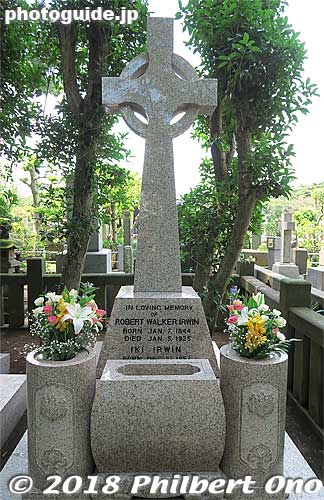 |
| Grave of Robert Walker Irwin, wife Iki, and daughter Bella at Aoyama Cemetery, Tokyo. (Gravestone was damaged by the March 2011 earthquake, but was restored in 2018.) |
The Robert Walker Irwin family spanning three generations is buried at Aoyama Cemetery in central Tokyo. The gravesite is at one of the corners of the cemetery's main intersection in the center of the cemetery. Aoyama Cemetery is near Gaienmae Station (Ginza subway line), Exit 4A. The Irwin gravesite is about a 15-min. walk from the subway station. (See map below.)
When you enter the gravesite, you will see two graves on the left, one grave and two stone monuments on the right, and the two main graves in the back. Robert Walker Irwin and wife Iki's grave is at the back of the gravesite on the right. Next to it on the left is eldest son Robert Walker Irwin Jr. and his wife Fusako's grave.
On the left side is the grave of second son Richard Irwin's grave and his son Takeo and daughter Yukiko. Next to it is the grave of Robert Walker Irwin's second daughter Mary Irwin.
The grave on the right side is for Tsuneko Irwin (second wife of Robert Walker Irwin Jr.) and her son John. Next to it is a stone monument written with the biography of Robert Walker Irwin and a smaller monument for Bella Irwin that includes a short biography. (Click on the thumbnail to enlarge the image.)
Author's Notes
Robert Walker Irwin first caught my attention when I visited Ikaho, Gunma for the first time in Aug. 2003 during its annual Hawaiian Hula Festival. There was a "Hawaiian Minister's House" and I promptly visited it. The house displayed much information about the Irwin family and Japanese immigration to Hawaii. It also had an informative pamphlet in Japanese about Irwin and the immigration. Unfortunately, nothing was in English. That was too bad because the hula dancers, musicians, and others from Hawaii were visiting the house during the Ikaho hula festival. (They can't read Japanese.) I have offered this article to be photocopied and made available at the Irwin house.
After visiting Ikaho, I tried to find more information about Robert Walker Irwin, and was disappointed that there was very little information despite the historical importance of this man. The most information I found about Irwin was at the Ikaho house and in the Hawaiian Kingdom history book by Ralph S. Kuykendall (see References below). A chapter in the book gives a good account of how the Japanese immigration was started and Irwin's role. But it does not delve into his life and dealings in Japan.
It's incredible to find a man who apparently never lived in Hawaii to have been entrusted with such an important task and be involved so deeply with Hawaii and its future history. Ironically, it seems that he is better recognized and written about in Japan than in Hawaii. The Japanese government bestowed its highest awards (Order of the Rising Sun, etc.) on him multiple times. The Hawaiian government also awarded him multiple medals. Irwin may have been long forgotten after the much larger mass immigration occurring after the Kanyaku Imin. Nevertheless, Irwin was wealthy, and he made a fortune from the immigration program by charging a commission for each adult male he delivered to Hawaii. He continued to have successful business pursuits even after his immigration work was done. He lived a comfortable and privileged life in Japan.
In spring 2008, I finally got around to writing this article about Robert Walker Irwin when I was hired again to work at Ikaho's hula festival that summer. I just wanted the people from Hawaii to know more about this man since there was so little information about him. I spent a few days piecing together all the information I could find about him in the few English and Japanese sources at hand.
I think Irwin deserves more recognition in the English-speaking world. So here's my contribution to that end. I attended the Ikaho Hawaiian Festival in Aug. 2008 and I gave copies of this article to the people from Hawaiʻi and to people at the Shibukawa City Hall and tourist bureau. It was very well received by all.
I'm happy to report that since 2008, I have come across more information about Robert Walker Irwin and his descendants and met a few heirs of his estate who have allowed me to examine documents, letters, medals, and other artifacts from Robert Walker Irwin. This article has therefore been updated accordingly.
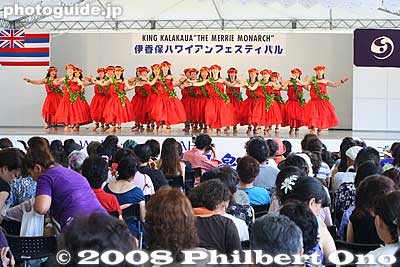 |
| Taking advantage of its Hawaii connection via Irwin's summer home, Ikaho holds an annual Hawaiian Festival in early Aug. highlighted by top hula dancers from Hawaii. More photos of the hula show here. |
I have always had a personal interest in people who served to bridge Japan and Hawaii (or the US). Irwin really struck a chord in me. He had a project to bridge a gap between Japan and Hawaii, worked at it to fruition, and executed it. It must have been immensely satisfying to take up such a task and making it happen. But it must have been disappointing to later hear stories of how badly some of the Japanese laborers were being treated by the exploitive employers. He really cared about Japan-Hawaii relations and the Japanese people. And he did it without being proficient at Japanese. Amazing.
He was one of the key people helping to create a new breed called Japanese-Americans. His original goals of supplying laborers (Japanese later accounted for over 60% of sugar plantation workers) and repopulating Hawaii (by 1910, 40% of Hawaii's population was Japanese, numbering almost 80,000, the largest ethnic group) were spectacularly attained. I wish he had lived long enough to see how the Japanese eventually excelled in Hawaii and made huge advancements and contributions to these islands and to America itself.
Though I'm a Japanese-American from Hawaii, I'm not descended from Japanese immigrants. But I grew up with them and their descendants. How I wish I was old enough and curious enough to ask the issei generation about their immigration experiences. As a child, I can only remember them as being old and wrinkled, but kind and gentle. How I wish I could have thanked them for all their kindnesses as I grew up. And even the nisei generation who are now dying out, as parents, teachers, public servants, and guardians who took care of us directly, I thank them as well.
Further Reading
- Discover Nikkei - Hawaiian Minister to Japan, by Philbert Ono
Major References
- Robert W. Irwin Bettei summer residence and pamphlet, Ikaho-cho Board of Education
- Guidance Facility, Ikaho
- Phila-Nipponica: A Historic Guide to Philadelphia & Japan, Second Edition, by the Japan America Society of Greater Philadelphia, 2015
- The Hawaiian Kingdom Volume III 1874-1893, The Kalakaua Dynasty, by Ralph S. Kuykendall, University of Hawaii Press, 1967
- Kanyaku Imin, A Hundred Years of Japanese Life in Hawaii, Edited by Leonard Lueras, International Savings and Loan Association Ltd., 1985
- Shoal of Time: A History of the Hawaiian Islands by Gavan Daws, University of Hawaii Press, 1974
- ハワイ管約移民の父 R.W.アーウィン, by 松永秀夫、(株)講談社ビジネスパートナーズ, 2011
- フランクリンの果実, by Yukiko Irwin, 文藝春秋, 1988
- Around the World with a King, William N. Armstrong
- カラカウア王のニッポン仰天旅行記、ウィリアム・N. アームストロング (著), William N. Armstrong (原著), 荒俣 宏 (翻訳), 樋口 あやこ (翻訳)
- Franklin Odo, Kazuko Shinoto 『図説 ハワイ日本人史1885~1924』Bishop Museum Press, 1985
- Cane Fires: The Anti-Japanese Movement in Hawaii, 1865-1945 By Gary Y. Okihiro, Temple University Press
- Japanese Overseas Migration Museum
- Irwin Gakuen Web site
- New York Times article archive
- Irwin summer residence by Shibukawa
